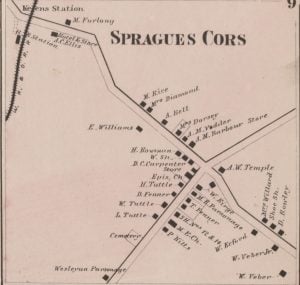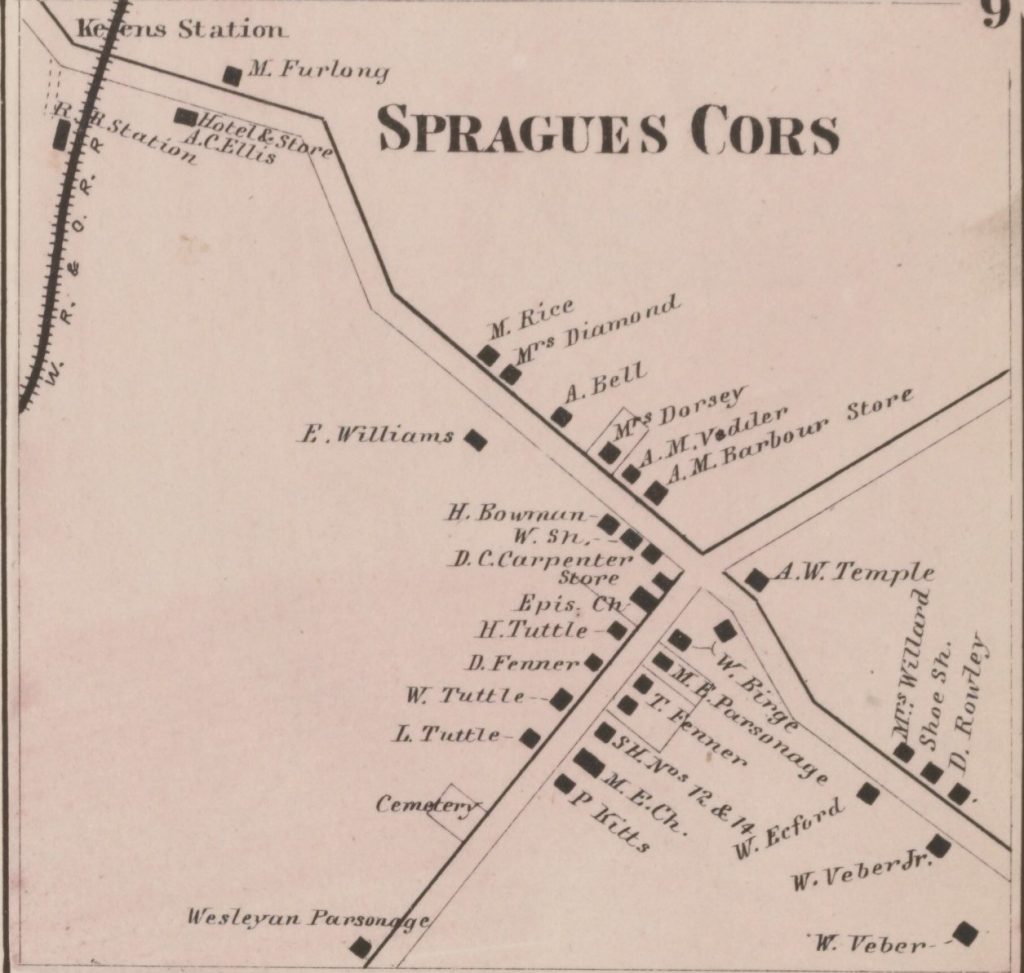
Sprague’s Corners is the name given to a cluster of buildings lying partly in Antwerp and partly in St. Lawrence county, at a point nearly half a mile southeast from the Rome, Watertown and Ogdensburgh railroad, at Keene’s Station, which name is often applied to the village.
The first settlers here were William Vebber and Moses and Robert Parkinson, brothers, from Massachusetts, who came in from the southwest, guided by marked trees and by the lines of lots, before the existence of a road to this point. Israel Sprague was another of the earliest settlers here, and it was from him that the settlement was named. Both he and Vebber lie in the graveyard on the hill at the westerly end of the village. Mr. Burge, the father of Moses Burge, was also one of the first who located here.
The village consists of a school-house, two churches (mention of which is made elsewhere), three stores, two blacksmith-shops, one wagon-shop, and about one hundred and fifty inhabitants. The post-office of Shingle Creek is also located here, but is in the county of St. Lawrence, as is also the greater part of the business of the place, the main street being also the county line, dividing the village between St. Lawrence and Jefferson. A public-house, the “Keene Station Hotel,” is located a short distance from the village, near the railroad track. This was built about 1859, by A. C. Ellis, now of Michigan, who also for a time carried on a general store in connection with it. The railroad from Watertown was opened to this place in the autumn of 1855. Colonel H. B. Keene was the company’s agent for eleven years, and it was for him that the station received its name.
History of the M. E. Church
Methodist worship was held in the neighborhood of Sprague’s fully fifty years ago, the meetings being usually held in the school-house about half a mile south of the village, or in that at Pike’s corners, — both log structures, — and the older people of the vicinity recollect Reverends Blay, Crary, Gibbs, and others, as among the early preachers who officiated.
The organization of the church was effected January 12, 1837, under Rev. Reuben Reynolds, pastor; the trustees being Isaac Sprague, John Howe, Elijah Steele, Jr., Abel Goodenough, William Brown, Martin Michel, and Samuel Kingsley.
In the same year they purchased of Moses Burge a building site on the Jefferson County side of the main street of the village, and upon it erected a house of worship, at a cost of about 11000; John Howe being the architect and builder. After thirty-six years of service, in 1873 this old building was demolished, and a new one their present church edifice — erected on the same site by C. C. Miller, as architect, at a cost of about 15000. This was during the ministry of Rev. Henry Heselgrave, now of Philadelphia. After his pastorate came that of Rev. Smith, who remained until 1876, and was then succeeded by Rev. Mr. Nichols, the present pastor.
History of the Free-Will Baptist Church
This organization was formed by a union of the Antwerp and Fowler Baptist society with the Wesleyan Methodists of Sprague’s Corners, effected about the year 1870. Their house of worship is the same which was built and occupied by the Wesleyans before the union. The present pastor is — Loomis. The membership is increasing rapidly, an accession of twenty members having been received during the winter of 1876-77.
The Wesleyan society, which was merged in the Free-Will Baptist, was formed September 1, 1845, with Emor Bell, Allen Woodward, and Abel Goodenough, trustees, it being the result of a secession from the M. E. church at Sprague’s Corners, caused by disagreement on the question of slavery. Allen Woodward donated a building site on the Antwerp road, towards the south side of the village, and upon it a small meeting-house was erected at a cost of $1500. This is the present church edifice of the Free-Will Baptists, as above mentioned. The Wesleyan pastor, at the time of uniting with the Baptists, was Elder Collins.
Source: Durant, Samuel W. and Henry B. Peirce. History of Jefferson County, New York, With Illustrations and Biographical Sketches of Some of its Prominent Men and Pioneers. Philadelphia: L.H. Everts & Co., 1878.
